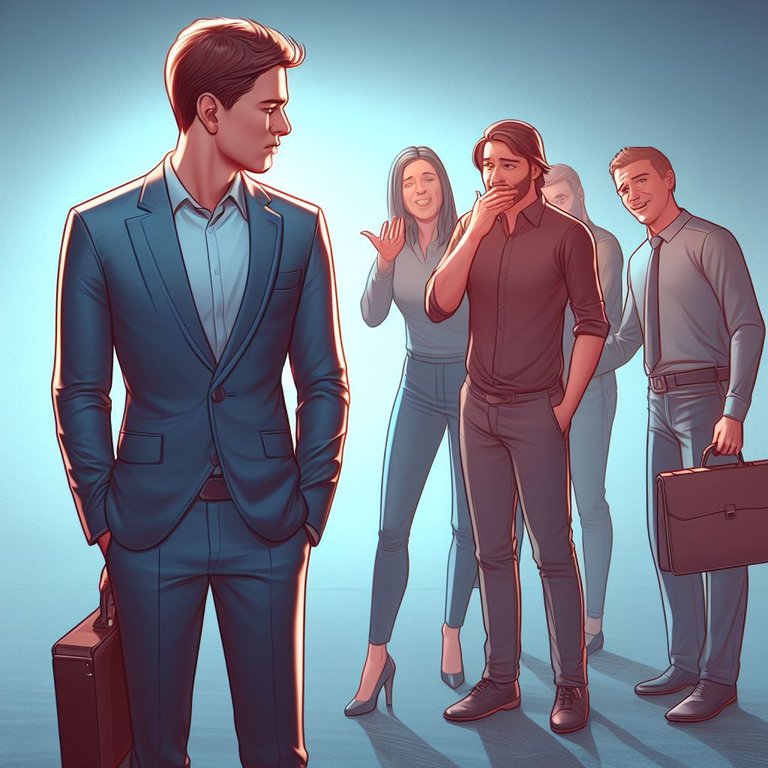Síndrome de Asperger y creatividad, ¿exclusivos o no? / Asperger syndrome and creativity, exclusive or not? (EN/ES)

El Síndrome de Asperger fue descrito por primera vez por el pediatra austriaco Hans Asperger en el 1944, lo cual coincidió sin que este lo supiera, con la publicación en 1943 sobre los trastornos autísticos del contacto afectivo del doctor Leo Kanner, que les dan sentido a la comprensión que existe actualmente sobre dicha temática. Ambas descripciones hacían referencia a aspectos muy peculiares de la conducta infantil como alteraciones del comportamiento social, el lenguaje y las habilidades cognitivas y, además, hacían referencia al término psicopatía autista para resaltar el aislamiento de sus pacientes.
Esta vez vengo a hablarles de este síndrome tan peculiar que poseen varias personas en el mundo, y que más allá de ser considerado por muchos como una enfermedad o un padecimiento, se trata de una condición más que nos corresponde con la que debemos aprender a lidiar ya que la poseen personas. Es simplemente otro modo de ser y estar en el mundo por parte de personas, no entidades nosológicas en sí mismas. Sin embargo, el objetivo de esta entrada de blog es establecer una relación entre dicha condición, y la creatividad. O sea, ¿qué es la creatividad?, ¿pueden las personas con síndrome de Asperger manifestar características creativas? Esta y otras interrogantes serán abordadas a continuación. Así que si te interesa el tema, quédate y lee hasta el final y te prometo que no te arrepentirás.
........................................
Introducción
Poco después del fallecimiento de Asperger en 1980, su trabajo fue aceptado por la comunidad médica internacional, por lo que tuvo que pasar casi cuarenta años desde la publicación sobre este síndrome, para que apareciera en la literatura científica. Ello dio origen al reinicio de las investigaciones en torno a dicho síndrome. Fue incluido en el Manual Diagnóstico y Estadístico de Trastornos Mentales, DSM por sus siglas en inglés, en el 1994.
La realidad de las personas con síndrome de Asperger es un tema de creciente importancia, hoy en día, en el mundo de la discapacidad, bien sea por el masivo diagnóstico de personas con síndrome de Asperger en los últimos años, o por la fuerza con la que defienden sus derechos las distintas asociaciones e instituciones que trabajan con el síndrome. (Parada, 2012, p. 5)

Existen múltiples interpretaciones mágicas en torno a las características autísticas antes mencionadas, que tienen como uno de sus principales exponentes a San Francisco de Asís, por sus conductas enrarecidas. Hasta hace relativamente poco, las personas con esta condición eran mal diagnosticadas, y, por tanto, desconocidas ante las sociedades o confundidas con otros trastornos. Se trata de un trastorno del desarrollo cerebral que se da desde el nacimiento y persiste durante la vida. Sus causas permanecen desconocidas, pero hay evidencias de una fuerte carga genética, así como causas orgánicas. Aunque aparezca generalmente como una variante del autismo, posee sus propias características que lo diferencian como mejores habilidades sociales o la inteligencia verbal.
Los factores de riesgos como los antecedentes familiares, prenatales, perinatales o personales que posibiliten la modificación del factor genético se desconocen. Actualmente existe muy poca información sobre le pronóstico de estos niños debido a lo expresado en la cita anterior.
La prevalencia exacta no se ha establecido exactamente, aunque se puede afirmar que es más común en hombres. Las tasas son de una media de 36 por 10000 niños, nacidos por año. «Como es una enfermedad crónica del comportamiento, no existe un patrón único de comorbilidad depende de las interacciones entre ambiente, herencia y paciente» (Naranjo, 2014, p. 82).
Desarrollo
Se hace importante un diagnóstico temprano de dicho síndrome, porque es necesario instaurar un tratamiento adecuado y mejorar el pronóstico al evitar la comorbilidad, debido a que, en mi opinión, de no ser así esto pudiera debutar en una inadecuada estimulación proveniente de las relaciones sociales, agudizar el síndrome y/o provocar un retardo del desarrollo psíquico. Se trata de una condición multidimensional y, por tanto, una etiología muy compleja. Es un trastorno que grosso modo se caracteriza por la marcada alteración social, dificultades en la comunicación, en el juego, rango de intereses repetitivos sin presentar retardos significativos del lenguaje ni del intelecto. Se trata de individuos que se aíslan socialmente ya que el acercamiento a otras personas es inapropiado por sus conductas excéntricas. Son incapaces de guardar secretos, entender metáforas, ironías, sarcasmo o el humor; de ahí la afectación de las relaciones sociales. Generalmente son personas que pretenden dominar la conversación, por lo que generan conversaciones unilaterales, con un único tema y muy rutinarias. «Fácilmente se perturban cuando sus expectativas no se cumplen, o sus rutinas son alteradas» (Naranjo, 2014, p. 84).

Puede que exista el interés por relacionarse con otras personas, pero la incapacidad está en que no reconocen sentimientos, así como intensiones ni comunicación no verbal, por lo que pueden parecer hirientes e insensibles, provocando el efecto contrario: el rechazo. Sin embargo, son hábiles en la esfera cognitiva, en la cual presentan una inteligencia normal, o en ocasiones superior a la media, que los hace tener conocimientos sobre temas particulares que causan asombro en quienes lo rodean.
Respecto al lenguaje, puede que presenten alguna diferencia al inicio, pero sin retrasos significativos. Sí puede ser que se vean afectadas las inflexiones y entonaciones, lo que causa que la velocidad sea inusual provocando que en ocasiones se pierda la fluencia. El volumen puede verse alterado y el lenguaje tangencial y circunstancial, siendo muy verbalizado, lo que los lleva a usar palabras inusuales. Pienso que en este punto guardan especial relación con las personas con autismo, ya que estas últimas no logran el control adecuado del volumen de la voz y, por tanto, pueden hablar casi gritando cuando hay personas cerca, o murmurar al contar con personas alejadas. Este puede ser uno de los motivos por los cuales aun aparezca dentro del espectro autista.
Suelen acumular buena cantidad de información sobre un tema en específico que los apasione, que condiciona el intercambio social, lo cual justifica lo que decía anteriormente sobre que tratan generalmente de dominar el curso de la conversación, por lo que se vuelve unilateral. Puede que presenten retardo en la adquisición de habilidades motoras como la coordinación, provocando una marcha anormal, posturas extrañas y en ocasiones, que se posicionen demasiado cerca de las demás personas, causando incomodidad y nuevamente, rechazo.

Los niños y niñas con Síndrome de Asperger muestran dificultades particulares en el procesamiento auditivo , ya que logran una pobre modulación sensitiva del 10 al 20 %. Además, en cuanto al procesamiento de la información visual normal dedican poco tiempo observando las características principales del rostro, como la boca y los ojos y gastan mucho tiempo en áreas diferentes a la cara. Aquí pienso que esto sea una causa de que se pierdan mucho de la información no verbal dada por los gestos faciales como las muecas, y sean torpes en la comprensión de sarcasmos e ironías.
Respecto al nivel conductual, «actualmente está muy aceptado el concepto de un espectro completo de trastornos autistas de distinto tipo e intensidad, que no se limitan a casos aislados, tal como lo describió Kanner» (Frith, p. 506). Uno de los principales problemas en torno a ello, es cómo identificar y consensuar rasgos significativos, puesto que el comportamiento es muy variable durante el desarrollo, por la particular relación del individuo con su entorno.
En el nivel cognitivo, es donde se puede hallar el denominador común, que es la proposición de la carencia de la llamada «Teoría de la mente». ¿Qué sería esta «Teoría de la mente»? Pues puede ser considerada como un proceso psicológico superior rudimentario que, según Vygotsky, surge en el contexto de las relaciones interpersonales por la participación del sujeto en una cultura determinada. Se constituye por un aprendizaje incidental al igual que el lenguaje; pues ningún adulto enseña conscientemente a comprender que los demás poseen mente, a atribuirles intencionalidad, comprender el sarcasmo o la ironía, a deducir el estado emocional de otra persona en una conversación o a jugar con el cambio de turnos en la misma, sino que esto es aprehendido mediante las relaciones. «Estos implican contextos mentales compartidos en los sistemas simbólicos de la cultura (familiar) y en las prácticas de participación guiada donde se apropian de las herramientas semióticas de su cultura» (Frith, p. 506).
Luego de haber comprendido a modo general, las características de las personas con Síndrome de Asperger, pasamos a realizarnos la pregunta: ¿estas personas pueden desarrollar características creativas o representaciones artísticas?, o mejor aún, ¿estas características contribuyen de alguna manera a superar alguna de sus discapacidades? Pues impulsivamente es probable que la mayoría de las personas respondan que no, debido a la dificultad de las relaciones sociales. Sin embargo, si nos fijamos en los artistas famosos, podemos darnos cuenta de que una cantidad considerable presenta Síndrome de Asperger. Muchos autores afirman que los genes del autismo y el Asperger, están fuertemente vinculados a los genes de la creatividad, y tenemos los ejemplos de Bob Dylan o Satoshi Tajiri (creador de la franquicia Pokémon), que presentaban características que encajaban con dicho síndrome.
Pues aparentemente las características del Síndrome de Asperger, no permiten a la persona manifestar características creativas. Entendamos la creatividad como el proceso de descubrimiento o producción de algo nuevo, que cumple con exigencias de una determinada situación social. Pues si estas personas presentan dificultades en el juego de roles, inflexibilidad mental y comportamental, y trastornos cualitativos de la relación, es muy difícil que sean creativos.
Por otra parte, existen autores como Fernández (2003) que establecen una relación entre el coeficiente intelectual (CI) con la creatividad, siendo los que poseen menos de 30, los que no desarrollan conductas creativas, los de entre 30 y 50 los que tendrán cierto rendimiento, y los que están entre 50 y 70, los que llegarán a resultados más apreciables, con lo cual no concuerdo particularmente.
En contraposición a ello, se conocen muchos ejemplos de personas que, con deficiencias, logran manifestar creatividad. Y si seguimos analizando las características de las personas con síndrome de Asperger, podemos ver que existen ciertas características que les presentan beneficios para manifestar procesos o productos creativos. Son personas que poseen una inteligencia normal y en ocasiones por encima de la media, lo cual está acorde con lo propuesto por la autora, poseen fijación con un determinado tema de su interés, lo cual les permite llegar a dominar la mayoría de las aristas de cierta problemática y hacer nuevos aportes, poseen buena capacidad memorística para captar detalles, lo cual les permite que no se les escape casi nada y ver donde los demás no alcanzan, y se trata de personas metódicas y rutinarias que esta característica les permite buena organización.

Conclusiones
A partir de todo lo visto hasta ahora, podemos al menos creer, que las personas con Síndrome de Asperger pueden llegar a ser creativas. Cuentan con varias características que funcionan como potencialidades para desarrollar procesos creativos. Pero aún no se ha respondido la pregunta referida a si en alguna medida, estas características llegan a superar alguna de sus discapacidades. La respuesta es afirmativa, pues «parece que las personas que sufren síndrome de Asperger pueden desarrollar una teoría de la mente alternativa, aunque su comprensión intuitiva de los estados mentales siga siendo pobre» (Frith, p. 506)
Estas personas a raíz de las características antes mencionadas que les permiten ser creativos, pueden desarrollar un tipo diferente de teoría, adquirida tarde y con mucho esfuerzo, algunas veces cometiendo errores. Pero lo importante es que pueden lograr una compensación que les posibilite un mínimo de aciertos en situaciones sociales. Es algo parecido a una teoría científica, puesto que es consciente y no inconsciente como lo sería cotidianamente. Carece de la intuición necesaria para el uso de la experiencia social desde la infancia temprana. Esta teoría alternativa, al ser lógica, no permite un rápido procesamiento y automaticidad, por el contario es trabajosa y exhaustiva, aunque mejora con el tiempo. Pero no por ello deja de funcionar como mecanismo de compensación, pues permite que la persona pueda funcionar mejor en su ambiente social y dar una mejor respuesta a lo que antes se le escapaba como la comunicación no verbal, el humor, la ironía.

........................................
English version

Asperger's Syndrome was first described by the Austrian pediatrician Hans Asperger in 1944, which coincided, unbeknownst to him, with the 1943 publication on autistic affective contact disorders by Dr. Leo Kanner, which gives meaning to the current understanding of the subject. Both descriptions referred to very peculiar aspects of child behavior such as alterations in social behavior, language and cognitive skills, and also referred to the term autistic psychopathy to highlight the isolation of his patients.
This time I come to talk about this peculiar syndrome that several people in the world have, and that beyond being considered by many as a disease or a condition, it is another condition that we must learn to deal with because people have it. It is simply another way of being and being in the world by people, not nosological entities per se. However, the purpose of this blog entry is to establish a relationship between this condition, and creativity. That is, what is creativity, can people with Asperger syndrome manifest creative characteristics? This and other questions will be addressed below. So if you are interested in the subject, stay and read until the end and I promise you will not regret it.
........................................
Introduction
Shortly after Asperger's death in 1980, his work was accepted by the international medical community, so it took almost forty years after the publication of this syndrome for it to appear in the scientific literature. This led to the resumption of research on the syndrome. It was included in the Diagnostic and Statistical Manual of Mental Disorders (DSM) in 1994.
The reality of people with Asperger syndrome is a topic of growing importance today in the world of disability, either by the massive diagnosis of people with Asperger syndrome in recent years, or by the strength with which the various associations and institutions working with the syndrome defend their rights. (Parada, 2012, p. 5).

There are multiple magical interpretations of the aforementioned autistic characteristics, one of the main exponents of which is Saint Francis of Assisi, due to his rarefied behaviors. Until relatively recently, people with this condition were misdiagnosed, and therefore unknown to societies or confused with other disorders. It is a disorder of brain development that occurs from birth and persists throughout life. Its causes remain unknown, but there is evidence of a strong genetic burden as well as organic causes. Although it usually appears as a variant of autism, it has its own differentiating characteristics such as improved social skills or verbal intelligence.
The risk factors such as family, prenatal, perinatal or personal history that make possible the modification of the genetic factor are unknown. Currently there is very little information on the prognosis of these children due to the above mentioned.
The exact prevalence has not been established exactly, although it can be stated that it is more common in males. Rates average 36 per 10000 children, born per year. "As it is a chronic behavioral disease, there is no single pattern of comorbidity depends on the interactions between environment, heredity and patient" (Naranjo, 2014, p. 82).
Development
An early diagnosis of such syndrome becomes important, because it is necessary to establish an adequate treatment and improve the prognosis by avoiding comorbidity, due to the fact that, in my opinion, otherwise this could debut in an inadequate stimulation coming from social relationships, aggravate the syndrome and/or cause a retardation of psychic development. It is a multidimensional condition and, therefore, a very complex etiology. It is a disorder that is characterized by marked social disturbance, difficulties in communication, play, range of repetitive interests without presenting significant delays in language or intellect. These are individuals who socially isolate themselves since the approach to other people is inappropriate due to their eccentric behaviors. They are unable to keep secrets, understand metaphors, ironies, sarcasm or humor; hence the affectation of social relationships. They are generally people who seek to dominate the conversation, so they generate unilateral conversations, with a single topic and very routine. "They are easily disturbed when their expectations are not met, or their routines are altered" (Naranjo, 2014, p. 84).

There may be interest in relating to other people, but the disability lies in the fact that they do not recognize feelings, as well as intentions or nonverbal communication, so they may appear hurtful and insensitive, causing the opposite effect: rejection. However, they are skilled in the cognitive sphere, in which they have a normal intelligence, or sometimes above average, which makes them have knowledge on particular topics that cause astonishment in those around them.
Regarding language, they may present some differences at the beginning, but without significant delays. Inflections and intonations may be affected, which causes the speed to be unusual, sometimes leading to a loss of fluency. Volume may be altered and language may be tangential and circumstantial, being very verbalized, leading them to use unusual words. I think that in this point they are especially related to people with autism, since the latter do not achieve adequate control of the volume of the voice and, therefore, they can speak almost shouting when there are people nearby, or mumble when there are people far away. This may be one of the reasons why it still appears within the autism spectrum.
They tend to accumulate a good amount of information on a specific topic they are passionate about, which conditions the social exchange, which justifies what I said before about them generally trying to dominate the course of the conversation, so it becomes unilateral. They may present a delay in the acquisition of motor skills such as coordination, causing an abnormal gait, strange postures and sometimes, they position themselves too close to other people, causing discomfort and again, rejection.

Children with Asperger Syndrome show particular difficulties in auditory processing, as they achieve a poor sensory modulation of 10 to 20 %. In addition, in terms of processing normal visual information, they spend little time looking at the main features of the face, such as the mouth and eyes, and spend a lot of time on areas other than the face. Here I think this is a cause of them missing much of the nonverbal information given by facial gestures such as grimaces, and they are clumsy in understanding sarcasm and irony.
Regarding the behavioral level, "the concept of a full spectrum of autistic disorders of different types and intensity, which are not limited to isolated cases, as described by Kanner, is now widely accepted" (Frith, p. 506). One of the main problems is how to identify and agree on significant traits, since behavior is highly variable during development, due to the particular relationship of the individual with his environment.
At the cognitive level, is where the common denominator can be found, which is the proposition of the lack of a so-called "Theory of Mind". What would this "Theory of mind" be? Well, it can be considered as a rudimentary higher psychological process that, according to Vygotsky, arises in the context of interpersonal relationships due to the participation of the subject in a given culture. It is constituted by incidental learning just like language; for no adult consciously teaches to understand that others possess minds, to attribute intentionality to them, to understand sarcasm or irony, to deduce the emotional state of another person in a conversation, or to play with turn-taking in conversation, but this is apprehended through relationships. "These involve shared mental contexts in the symbolic systems of (family) culture and in guided participation practices where they appropriate the semiotic tools of their culture" (Frith, p. 506).
After having understood in a general way, the characteristics of people with Asperger's Syndrome, we can ask ourselves the question: can these people develop creative characteristics or artistic representations, or better yet, do these characteristics contribute in any way to overcome any of their disabilities? Impulsively, it is likely that most people would answer no, due to the difficulty of social relationships. However, if we look at famous artists, we can see that a considerable number have Asperger's Syndrome. Many authors claim that autism and Asperger's genes are strongly linked to creativity genes, and we have the examples of Bob Dylan or Satoshi Tajiri (creator of the Pokémon franchise), who presented characteristics that fit with this syndrome.
Apparently, the characteristics of Asperger's Syndrome do not allow the person to manifest creative characteristics. Let us understand creativity as the process of discovery or production of something new, which meets the requirements of a given social situation. For if these people present difficulties in role playing, mental and behavioral inflexibility, and qualitative relationship disorders, it is very difficult for them to be creative.
On the other hand, there are authors such as Fernandez (2003) who establish a relationship between IQ and creativity, being those who have less than 30, those who do not develop creative behaviors, those between 30 and 50 those who will have some performance, and those who are between 50 and 70, those who will reach more appreciable results, with which I do not particularly agree.
On the other hand, there are many examples of people who, with deficiencies, manage to show creativity. And if we continue analyzing the characteristics of people with Asperger's Syndrome, we can see that there are certain characteristics that present them with benefits to manifest creative processes or products. They are people who have a normal intelligence and sometimes above average, which is in accordance with what is proposed by the author, they have a fixation with a certain subject of their interest, which allows them to master most of the edges of certain problems and make new contributions, they have good memory capacity to grasp details, which allows them not to miss almost anything and see where others do not reach, and they are methodical and routine people that this feature allows them good organization.

Conclusions
From all we have seen so far, we can at least believe that people with Asperger Syndrome can become creative. They have several characteristics that function as potentialities to develop creative processes. But the question has not yet been answered as to whether, to some extent, these characteristics can overcome any of their disabilities. The answer is affirmative, for "it seems that people with Asperger's Syndrome can develop an alternative theory of mind, even if their intuitive understanding of mental states remains poor" (Frith, p. 506).
These people, as a result of the above-mentioned characteristics that allow them to be creative, can develop a different kind of theory, acquired late and with much effort, sometimes making mistakes. But the important thing is that they can achieve a compensation that allows them a minimum of successes in social situations. It is something similar to a scientific theory, since it is conscious and not unconscious as it would be in everyday life. It lacks the intuition necessary for the use of social experience from early childhood. This alternative theory, being logical, does not allow rapid processing and automaticity, on the contrary it is laborious and exhaustive, although it improves with time. But it does not cease to function as a compensatory mechanism, since it allows the person to function better in his social environment and to give a better response to what previously escaped him, such as non-verbal communication, humor, irony.


Créditos / Credits
Referencias bibliográficas / Bibliographic references:
Frith, U. (1998). Autismo y Síndrome de Asperger. En Congreso Internacional Autismo-Europa, La esperanza no es un sueño (págs. 505-514). Fundación ONCE.
https://www.google.com/url?sa=t&source=web&rct=j&opi=89978449&url=https://www.autisme.com/autisme/documents/Autismo-y-sindrome-de-asperger.pdf&ved=2ahUKEwips6fyicGCAxUPLFkFHaihDuQQFnoECBYQAQ&usg=AOvVaw0FZDsuHV1ANkEYAKHJR62kFernández, M. (2003). Creatividad, arte terapia y autismo. Un acercamiento a la actividad plástica como proceso creativo en niños autistas. Arte, individuo y sociedad, (15), 135-152. https://www.google.com/url?sa=t&source=web&rct=j&opi=89978449&url=https://dialnet.unirioja.es/servlet/articulo%3Fcodigo%3D794482&ved=2ahUKEwjhr-fHisGCAxVGGVkFHRoqD0wQFnoECAoQAQ&usg=AOvVaw0S2Y2195Fyj2uA_ZdjigTk
Parada, AJ. (2012). El síndrome de Asperger y la creatividad (Tesis de maestría). Universidad de Oviedo, España. https://www.google.com/url?sa=t&source=web&rct=j&opi=89978449&url=https://digibuo.uniovi.es/dspace/bitstream/10651/3990/1/TFM_AlejandroJacob_Parada_&ved=2ahUKEwjUrMH8jsGCAxVeM1kFHcupBvoQFnoECBIQAQ&usg=AOvVaw2AVCc6MnkhMDp9h33wFDcO
Campà, A. (2013). Habilidades sociales: una aplicación al Síndrome de Asperger (Prácticas de Psicología de la Educación). Universitat Oberta de Catalunya, España. https://www.google.com/url?sa=t&source=web&rct=j&opi=89978449&url=https://openaccess.uoc.edu/bitstream/10609/20141/6/agarciacamTFC0113mem%25C3%25B2ria.pdf&ved=2ahUKEwi8t6fZkMGCAxXDMlkFHZl7BGAQFnoECAwQAQ&usg=AOvVaw0j7K8BPPoaH4HCQfU1D97Z
Naranjo, RA. (2014). Avances y perspectivas en Síndrome de Asperger. NOVA, 12 (21), 81-101. http://dx.doi.org/10.22490/24629448.998
Imágenes utilizadas / Images used:
Imágenes de mi propiedad generadas con la IA de Bing Image Creator / Images I own generated with Bing Image Creator AI.
Traducción / Translation:
DeepL
Thanks for your contribution to the STEMsocial community. Feel free to join us on discord to get to know the rest of us!
Please consider delegating to the @stemsocial account (85% of the curation rewards are returned).
You may also include @stemsocial as a beneficiary of the rewards of this post to get a stronger support.
Congratulations @genrigp! You have completed the following achievement on the Hive blockchain And have been rewarded with New badge(s)
Your next target is to reach 4000 upvotes.
You can view your badges on your board and compare yourself to others in the Ranking
If you no longer want to receive notifications, reply to this comment with the word
STOPCheck out our last posts: